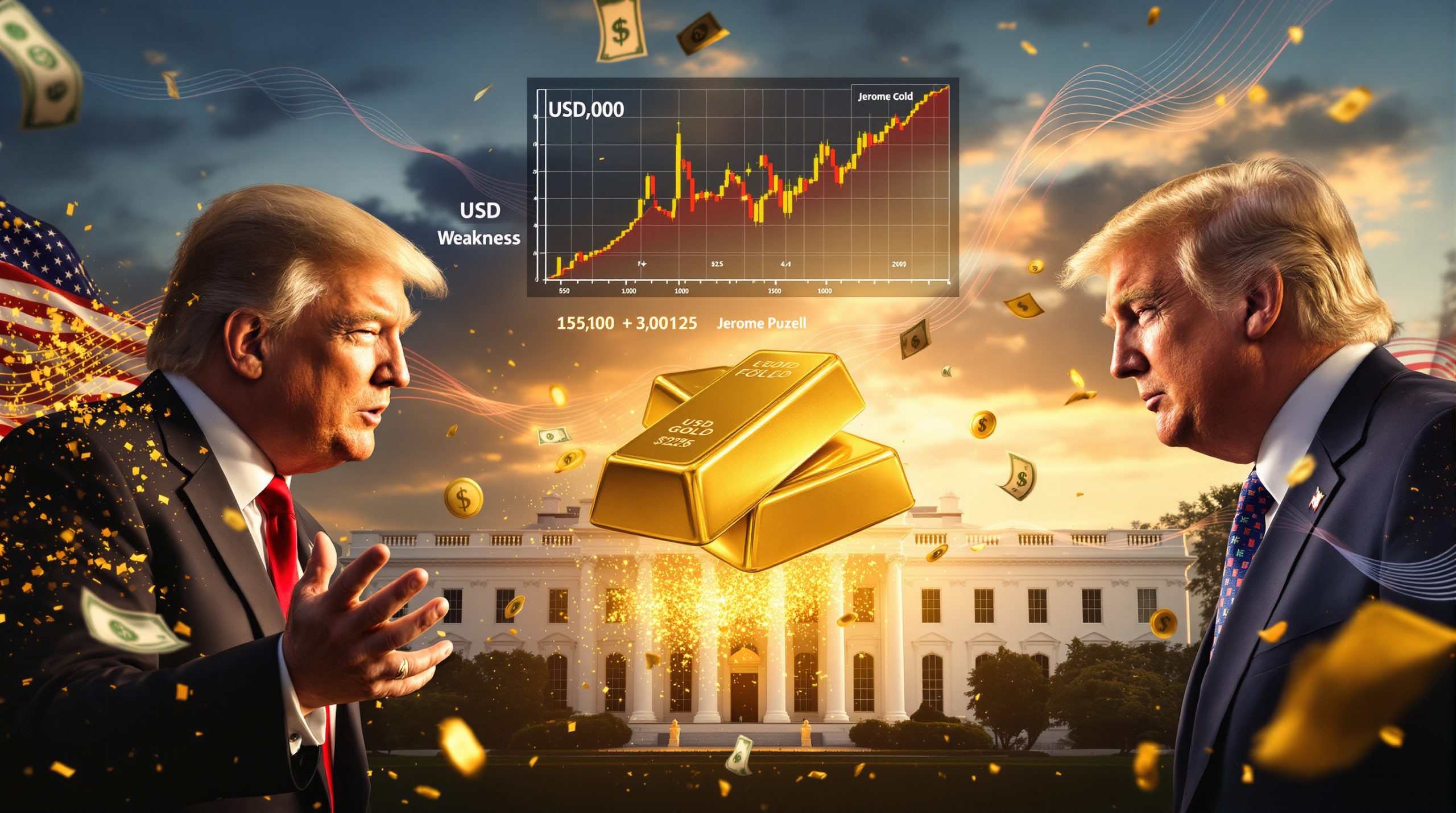The precious metals sector has shown remarkable resilience following recent market turbulence, with both gold and silver recovery signs emerging that suggest the October correction may be nearing completion. Gold has successfully reclaimed the psychologically important $4,000 threshold, whilst silver has demonstrated even stronger recovery momentum, surging over 4% to climb back above $48 per ounce.
Understanding the Recent Precious Metals Correction
Following a period of significant volatility through October 2025, both gold and silver markets are demonstrating encouraging stabilisation patterns that suggest potential recovery momentum. The precious metals sector experienced considerable turbulence, with gold retreating from its historic peak above $4,200 per ounce during a nine-day decline that tested investor confidence across global markets.
Recent market data reveals compelling recovery indicators across both metals. Gold, having touched a low of $3,887.99 per ounce, has successfully reclaimed the psychologically important $4,000 threshold, representing a notable 2.8% advance in 24-hour trading. Furthermore, the gold highs analysis reveals this recovery demonstrates the metal's underlying strength despite recent volatility.
Silver has demonstrated even stronger recovery momentum, surging over 4% in the same period to climb back above $48 per ounce. This showcases the metal's characteristic volatility patterns, with technical indicators suggesting the silver market squeeze has contributed to these amplified price movements.
Key Price Movement Statistics
Table: Recent Precious Metals Recovery Data
| Metal | Recent Low | Current Recovery Level | 24-Hour Change | YTD Performance 2025 |
|---|---|---|---|---|
| Gold | $3,887.99/oz | Above $4,000/oz | +2.8% | +50% |
| Silver | Below $48/oz | $48.00+/oz | +4.2% | +66% |
| Gold (GBP) | Below £3,000/oz | Above £3,000/oz | +2.8% | Significant gains |
| Silver (EUR) | Below €41/oz | Above €41/oz | +4.2% | Strong performance |
The recovery momentum has been particularly pronounced in silver markets, which historically demonstrate amplified volatility compared to gold during both correction and recovery phases. Despite recent setbacks, both metals maintain substantial year-to-date gains, with silver advancing 66% and gold appreciating 50% through late October 2025.
Currency cross-references demonstrate the global nature of this recovery. Gold has reclaimed £3,000 per ounce in British pounds and €3,400 in euros, whilst silver has returned above £36 per ounce and €41 in euro terms, indicating broad-based demand across multiple currency zones.
What Technical Indicators Signal a Precious Metals Recovery?
Technical analysis reveals several compelling formations suggesting the recent correction may represent a constructive consolidation rather than a fundamental trend reversal. Professional chart analysts are identifying multiple bullish configurations across both precious metals that historically precede recovery phases, with technical analysis insights providing additional clarity on these patterns.
Chart Pattern Analysis
Gold is currently exhibiting characteristics consistent with a double-bottom formation, a technical pattern historically associated with trend reversals and upward momentum resumption. This configuration typically emerges when an asset tests a previous low, fails to break significantly below that level, and subsequently demonstrates buying interest at those oversold levels.
Silver markets are displaying different but equally encouraging technical developments. The metal is breaking through descending channel resistance levels that had contained prices during the recent correction period. This breakout suggests potential acceleration in recovery momentum if sustained above these technical thresholds.
Momentum Oscillator Readings
Relative Strength Index measurements for both metals have reached territories typically associated with oversold conditions. These readings suggest the recent price declines may represent healthy market consolidation rather than fundamental weakness. However, these readings historically correlate with favourable risk-reward entry points for investors considering precious metals exposure.
Moving Average Convergence Divergence indicators are similarly demonstrating potential reversal characteristics. Momentum oscillators suggest underlying strength despite recent price volatility, providing quantitative support for the recovery thesis across both gold and silver markets. Moreover, early signs of recovery are becoming increasingly evident across multiple technical indicators.
Market Insight: Technical analysis suggests current precious metals positioning offers improved risk-reward dynamics compared to recent peak levels, potentially creating favourable entry conditions for strategic investors.
How Are Central Banks Influencing Recovery Prospects?
Central banking institutions continue implementing strategic reserve diversification programmes that provide fundamental support for precious metals markets during volatile periods. These systematic purchasing patterns create sustained demand floors that help stabilise prices during correction phases and support recovery momentum.
Systematic Gold Accumulation Patterns
Emerging market central banks have maintained consistent precious metals accumulation strategies throughout 2025. This demonstrates institutional confidence in gold's reserve asset characteristics, operating independently of short-term technical factors whilst providing structural demand support that underpins long-term price stability.
The strategic nature of central bank accumulation creates demand patterns that are relatively price-inelastic. This means purchasing continues even during volatile periods, providing fundamental support for recovery prospects and helping establish price floors during correction phases.
Silver's Emerging Central Bank Interest
A notable development in precious metals markets involves the first documented instances of central banks incorporating silver into their reserve portfolios during the current metals cycle. This represents a significant paradigm shift for silver, which has historically been positioned primarily as an industrial and investment metal rather than a monetary reserve asset.
This institutional recognition of silver's monetary characteristics could provide additional fundamental support for recovery prospects. Given silver's smaller market size compared to gold, even modest central bank allocation increases could create substantial price impacts.
What Role Does Federal Reserve Policy Play in Recovery Signs?
Federal Reserve monetary policy decisions remain a critical catalyst influencing precious metals performance trajectories. Market participants have closely monitored interest rate expectations, with current probabilities strongly favouring accommodative policy measures that historically support precious metals valuations.
Interest Rate Decision Impact
The CME FedWatch Tool indicated a 99.9% probability of a 25 basis point interest rate reduction as of late October 2025. This represents near-universal market consensus regarding Federal Reserve policy direction, suggesting the anticipated rate cut was largely incorporated into precious metals pricing ahead of the official announcement.
However, monetary policy impacts extend beyond individual rate decisions to encompass broader policy trajectories and inflation expectations. The Federal Reserve faces competing pressures, with persistent inflation concerns balanced against political pressure for faster rate reductions, creating ongoing uncertainty about future policy directions. In addition, gold as an inflation hedge remains a key consideration for investors navigating these policy uncertainties.
Opportunity Cost Dynamics
Lower interest rate environments reduce the opportunity cost associated with holding non-yielding assets like gold and silver. This makes them more attractive relative to interest-bearing alternatives, creating a structural tailwind for precious metals during periods of monetary accommodation.
Real interest rates, which adjust nominal rates for inflation expectations, provide an even more direct correlation with precious metals performance. Declining real rates historically coincide with stronger gold and silver performance, as investors seek inflation hedges and alternative stores of value.
Are Industrial Demand Factors Supporting Silver's Recovery?
Silver's industrial applications continue expanding across multiple high-growth technological sectors. This creates structural demand that provides fundamental support during market corrections, distinguishing silver from gold and creating price-inelastic consumption patterns that support recovery prospects.
Technology Sector Requirements
Silver demand from renewable energy infrastructure, electric vehicle manufacturing, and advanced electronics production continues growing as these sectors expand globally. These applications utilise silver's unique physical properties, including superior electrical conductivity and thermal characteristics that cannot be easily substituted with alternative materials.
The price-inelastic nature of much industrial silver demand means that consumption continues even during periods of price volatility. This provides fundamental support for recovery momentum, as technology manufacturers typically maintain strategic inventory levels and cannot easily defer silver consumption without disrupting production schedules.
Supply Constraint Dynamics
Table: Silver Supply-Demand Fundamental Factors
| Supply Factor | Impact on Recovery Prospects |
|---|---|
| Declining ore grades globally | Limits production growth capacity |
| Environmental regulations | Increases mining operational costs |
| Industrial demand growth | Creates structural supply deficits |
| Investment demand fluctuations | Amplifies price movement patterns |
Declining ore grades at silver mining operations worldwide present long-term supply constraints that support higher price levels over time. Environmental regulations in major producing regions increase operational costs, creating higher breakeven prices for mining operations and supporting price floors during correction periods.
London Silver Market Liquidity
Silver lease rates in the London market have moderated significantly from extreme levels recorded earlier in October 2025. These rates declined from peaks of 34.9% on October 9th to approximately 5.6% by October 28th, demonstrating improving market liquidity conditions that reduce supply-side bottlenecks.
However, lease rates of 5.6% remain substantially elevated compared to historical norms. This indicates continued supply tightness in physical silver markets, suggesting that any increase in investment demand could rapidly accelerate recovery momentum due to limited available inventory.
What Do Professional Forecasts Indicate for Recovery Potential?
Industry professionals maintain optimistic outlooks for both precious metals despite recent volatility. Institutional forecasts suggest substantial upside potential from current price levels, with professional conferences and industry surveys revealing consensus expectations for continued precious metals appreciation through 2026. The gold price forecast supports these optimistic projections.
Analyst Price Projections
The London Bullion Market Association's recent Global Precious Metals Conference generated consensus forecasts targeting $4,980 per ounce for gold by late 2026. This represents approximately 25% appreciation from current recovery levels, suggesting continued bullish sentiment among industry participants despite recent correction volatility.
Silver projections demonstrate similar optimism, with professional forecasts targeting $59 per ounce. This indicates substantial recovery potential from recent correction lows, reflecting professional assessment of fundamental supply-demand dynamics and macroeconomic factors supporting precious metals appreciation.
Investment Institution Perspectives
Major financial institutions have maintained positive precious metals allocations throughout the recent volatility period. Exchange-traded fund inflows reached multi-year highs during 2025, demonstrating institutional confidence and sophisticated investors' long-term conviction in precious metals despite short-term price fluctuations.
Institutional demand patterns suggest professional money managers view recent corrections as consolidation phases within broader uptrend cycles. This positioning provides additional fundamental support for recovery prospects as institutional flows typically provide sustained demand patterns.
How Do Geopolitical Factors Influence Recovery Signs?
Global uncertainty continues supporting safe-haven demand characteristics for precious metals, despite recent developments creating mixed impacts on positioning strategies. International trade relationships and geopolitical tensions remain important drivers of precious metals demand patterns.
Safe-Haven Demand Patterns
Traditional flight-to-quality investment flows remain active during periods of economic or political uncertainty. These flows provide fundamental support for gold and silver prices independent of technical correction phases, operating based on risk perception rather than price levels and creating buying interest during volatile periods.
Recent developments in US-China trade relationships, including potential trade agreement progress, have created some risk-on sentiment that temporarily reduced safe-haven precious metals demand. Consequently, underlying geopolitical tensions continue supporting structural demand for alternative monetary assets.
Trade Policy Implications
Trade policy developments create both direct and indirect impacts on precious metals markets through their effects on currency relationships, inflation expectations, and economic growth prospects. Policy uncertainty often increases precious metals demand regardless of specific policy outcomes due to their hedge characteristics.
The resolution of certain trade tensions has contributed to temporary risk-on sentiment. However, ongoing global uncertainties continue providing fundamental support for precious metals as portfolio diversification assets and inflation hedges, with tentative signs of stability emerging in recent market analysis.
Which Recovery Scenarios Are Most Likely in 2026?
Multiple recovery pathways remain possible for precious metals markets, ranging from gradual appreciation scenarios to more accelerated rally phases depending on macroeconomic developments and market catalysts. Professional assessments suggest base case scenarios favour steady appreciation supported by fundamental demand drivers.
Base Case Recovery Projections
Moderate recovery scenarios anticipate gradual price appreciation supported by sustained central bank demand, growing industrial requirements, and continued monetary policy accommodation. This pathway suggests steady gains rather than explosive rallies, with recovery momentum building over multiple quarters.
Base case projections incorporate assumptions about stable geopolitical conditions, moderate economic growth, and continued central bank precious metals accumulation. These scenarios suggest precious metals appreciation rates consistent with historical cycles whilst avoiding extreme volatility.
Accelerated Recovery Catalysts
Several factors could trigger more rapid recovery phases that exceed base case projections:
• Geopolitical escalation driving increased safe-haven investment flows
• Monetary policy shifts exceeding current market expectations toward accommodation
• Supply disruptions in major precious metals producing regions
• Industrial demand surges from accelerated technology sector expansion
• Currency debasement concerns increasing alternative monetary asset demand
These catalysts could create positive feedback loops where initial price appreciation attracts additional investment demand. Consequently, this could further accelerate recovery momentum beyond baseline scenarios.
How Should Investors Interpret Current Recovery Signs?
Current market conditions present complex risk-reward dynamics that require careful analysis of multiple factors including technical positioning, fundamental demand drivers, and macroeconomic environments. Investors should consider both opportunities and risks associated with precious metals positioning during recovery phases.
Risk-Reward Assessment Framework
Technical indicators suggesting oversold conditions create potentially favourable entry points. However, investors should consider position sizing appropriate to their risk tolerance and investment timeline. Precious metals volatility requires strategic approaches that account for short-term price fluctuations within longer-term investment strategies.
Gold and silver recovery signs should be evaluated within broader portfolio contexts, considering precious metals' correlation characteristics with other asset classes during various market environments. Furthermore, diversification benefits may be particularly valuable during periods of economic uncertainty or monetary policy transition.
Portfolio Allocation Considerations
Professional investment advisors typically recommend precious metals allocations ranging from 5% to 15% of total portfolio value. This depends on individual risk profiles and investment objectives, with current recovery signs potentially supporting tactical allocation increases within these strategic ranges.
Investment timing strategies should balance early positioning opportunities against confirmation of sustained recovery momentum. Some investors prefer gradual accumulation approaches that reduce timing risk whilst maintaining exposure to potential appreciation.
Investment Strategy Insight: Current precious metals recovery indicators suggest potential opportunity for strategic positioning, but investors should maintain disciplined approaches that account for continued volatility possibilities whilst capturing long-term appreciation potential.
Market Psychology and Recovery Dynamics
Precious metals markets demonstrate distinct psychological patterns during recovery phases that influence both individual and institutional investment decisions. Understanding these behavioural dynamics provides additional insight into recovery sustainability and potential acceleration factors.
Investor Sentiment Shifts
Recovery phases typically involve gradual sentiment improvement as investors regain confidence following correction periods. This process often creates momentum effects where initial recovery signs attract additional investment interest, potentially accelerating price appreciation beyond fundamental justification.
Institutional investors often demonstrate different behavioural patterns compared to individual investors during recovery phases. Professional money managers typically maintain longer-term perspectives that support sustained demand even during short-term volatility periods.
Market Liquidity Improvements
The normalisation of silver lease rates from extreme levels demonstrates improving market liquidity conditions that reduce trading friction and support more efficient price discovery mechanisms. Enhanced liquidity typically supports recovery sustainability by reducing volatility and improving market depth.
However, lease rates remaining above historical norms indicate continued underlying supply constraints that could amplify price movements if investment demand increases substantially. This dynamic creates potential for both upside acceleration and continued volatility.
Conclusion: Evaluating the Gold and Silver Recovery Outlook
The convergence of technical stabilisation signals, fundamental demand drivers, and supportive macroeconomic conditions creates a potentially favourable environment for precious metals recovery continuation. Multiple indicators suggest the recent correction phase may have established constructive foundations for renewed appreciation cycles.
Technical analysis reveals oversold conditions that historically precede recovery phases, whilst fundamental factors including central bank accumulation, industrial demand growth, and monetary policy accommodation provide structural support for higher price levels. Professional forecasts maintain optimistic projections despite recent volatility, indicating sustained industry confidence.
However, investors should maintain awareness of continued volatility possibilities whilst positioning for potential recovery acceleration. The combination of technical oversold conditions, fundamental demand strength, and supportive policy environments suggests precious metals may offer attractive risk-adjusted return opportunities through 2026.
Key factors to monitor include Federal Reserve policy developments, central bank purchasing patterns, industrial demand trends, and geopolitical events that could influence safe-haven demand flows. Sustained recovery confirmation will likely require gold maintaining levels above $4,030 per ounce and silver holding above $47.90 per ounce on a consistent basis.
The gold and silver recovery signs observed in late 2025 reflect both cyclical correction completion and structural demand factors that support longer-term appreciation potential. Investors considering precious metals exposure should evaluate these recovery indicators within comprehensive portfolio strategies that account for both opportunities and risks associated with continued market evolution.
Disclaimer: Precious metals investments involve significant risks including price volatility and the potential for substantial losses. Past performance does not guarantee future results. Investors should conduct independent research and consider professional advice before making investment decisions. This analysis is for informational purposes only and does not constitute investment advice.
Are You Ready to Capitalise on the Next Precious Metals Discovery?
Discovery Alert's proprietary Discovery IQ model delivers instant notifications on significant ASX mineral discoveries, helping investors identify actionable opportunities in gold, silver, and other precious metals companies ahead of the broader market. Explore why historic discoveries generate substantial returns and begin your 30-day free trial today to position yourself strategically during this precious metals recovery phase.




